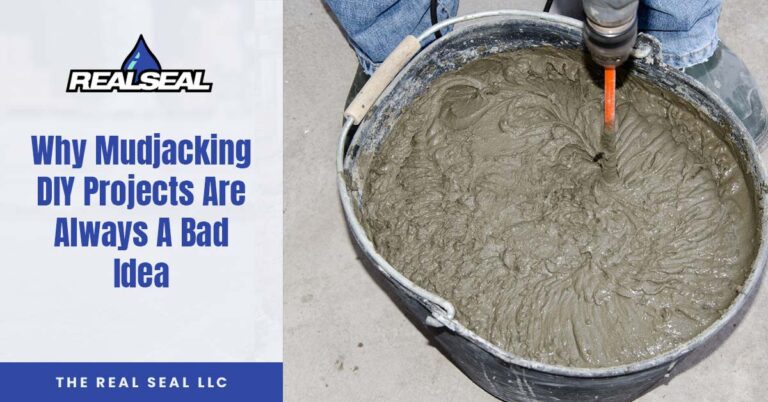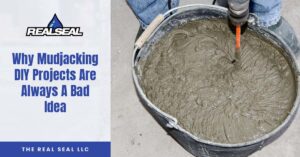If you want to know why mudjacking DIY projects are a bad idea, you’ve landed on the right page. In this short article, you’ll learn about the major issues with mudjacking DIY projects, why mudjacking itself is not an effective concrete leveling solution, and the solution that skilled professionals recommend.
What Is Mudjacking?
Mudjacking is a concrete lifting and leveling solution that uses a mixture of sand, cement, and topsoil. This combination of materials is called a “slurry” or “mud” and was created in the 1930s as a cheap alternative to lift and level concrete slabs. Contractors have also been known to include other additives into mudjacking in order to increase cure times or strengthen the mud, such as clay-bentonite, fly ash, pond sand, pea gravel, masonry segments, and crushed limestone.
What’s Involved In A Mudjacking DIY Project?
Like all DIY projects, mudjacking is no exception to human error. Most mudjacking DIY projects fail because homeowners don’t have the right tools or expertise to level a concrete slab without causing further damage or creating new issues. We’re going to break down a typical mudjacking DIY process, so we can show you what you’re up against.
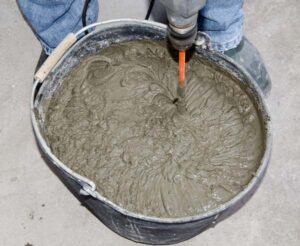
- Determine how much lift is needed – If you’re mudjacking a section of sidewalk or driveway, you’ll probably want to level it with the other sections. But if the entire surface is sinking, you will need to use elevation tools and rulers to lift it back to its original level. If you raise the concrete too high, you won’t be able to sink it back down.
- Cutting the slab – Some blog articles recommend cutting your concrete slab to raise it with mudjacking. Real professionals will never advise you to do this since this can crack your slab and potentially ruin its structural integrity.
- Drilling holes – In order to pump the slurry under the slab, you need to drill two-inch holes into the concrete using a hammer drill with a diamond drill bit. If done incorrectly, you could crack your concrete or drill holes in the wrong places.
- Creating the slurry – Unless you buy slurry from your local concrete supplier, you’ll need to make the mix yourself using water, sand, clay, topsoil, and Portland cement.
- Pump the slurry – Once you’ve made the slurry, you’ll need to transfer it to a hydraulic pump with a hose and nozzle. Next, you need to pump the slurry into the holes while holding down the nozzle with your foot. If your foot slips or you pump too much slurry under the slab, the whole process can be ruined. If you do this project yourself, pump the slurry slowly until your slab is leveled. Remember, you can always add more slurry, but you can’t remove it once it’s under your slab.
- Fill any cracks and holes – Once your slab is leveled, stop pumping the slurry and rinse the surface with a hose. Then, patch the holes and any cracks with a patching compound or repair caulk.
- Wait for the slurry to dry – You’ll need to wait 24 to 72 hours before walking over a mudjacked concrete slab. Otherwise, you could sink your slab again.
Why Mudjacking DIY Projects Fail
Here’s why mudjacking DIY projects fail after a few years and why mudjacking is not the best option.
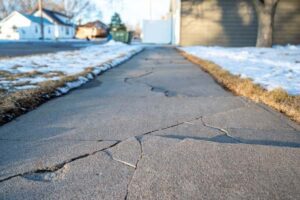
- It’s temporary – Because the slurry is weak and not waterproof, it will break down and shrink over time. Most concrete slabs leveled using mudjacking need to be lifted again in three to five years.
- It’s heavy – Mudjacking slurry can weigh around 100 pounds per cubic foot. When concrete slabs sink, it’s usually because the soil underneath can’t hold its weight. If you add this heavy slurry over weak soil, it will settle again and allow the slab to sink.
- It’s messy – When you pump the slurry into your concrete, you need to hold the nozzle down with your feet. If you can’t hold the weight of the slurry being pumped into the hole, mud could spill everywhere and leave a huge mess. This can also happen if the slurry shoots out the sides of the slab, such as a sidewalk.
- It’s old – Mudjacking was invented almost 100 years ago. Even though it’s a somewhat-effective solution, better inventions have come out, such as polyjacking.
The flaws we listed are not exclusive to DIY projects. Even professional mudjacking companies still have these issues. So, if mudjacking doesn’t work, what does?
Read more: DIY vs Why Try?
What’s Better Than Mudjacking?
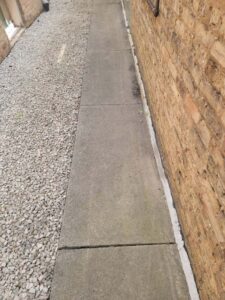
Polyjacking is a better alternative concrete leveling method than mudjacking. This durable and long-lasting solution uses an expanding polyurethane foam rather than a heavy and weak mud-based slurry. Unlike mudjacking slurry, polyurethane foam is hydrophobic and will not erode if it comes in contact with water. If water is draining toward your concrete slab, there’s a chance another void can form in another area, which is why you should always install a proper water drainage system, such as a French drain.
Polyjacking is less likely to crack your concrete during the process since the holes required to inject the foam are smaller than mudjacking holes. Contractors don’t need to use their feet to inject the foam since it uses a hand-held injection gun rather than just a hose. Overall, polyjacking is a cost-effective and lasting concrete leveling solution that saves you from the stress and risks of mudjacking.
Who Should You Call?
We wrote this article not to scare you but to inform you of all the risks of professional or DIY mudjacking projects. If you want a concrete leveling solution that actually works, call The Real Seal and ask about polyjacking. Our team of experts will inspect your concrete slab, find out why it’s sinking, correct the settlement, and offer you a wide range of solutions to prevent any future issues. For example, we also offer foundation waterproof solutions such as drain tile systems and French drains, which can prevent water from eroding the soil under your slab. Call today for your free inspection and more.
